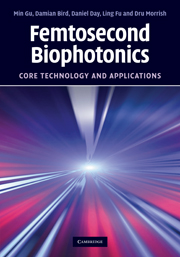Book contents
- Frontmatter
- Contents
- Preface
- 1 Introduction
- 2 Nonlinear optical microscopy
- 3 Two-photon fluorescence microscopy through turbid media
- 4 Fibre-optical nonlinear microscopy
- 5 Nonlinear optical endoscopy
- 6 Trapped-particle near-field scanning optical microscopy
- 7 Femtosecond pulse laser trapping and tweezers
- 8 Near-field optical trapping and tweezers
- 9 Femtosecond cell engineering
- Index
9 - Femtosecond cell engineering
Published online by Cambridge University Press: 07 May 2010
- Frontmatter
- Contents
- Preface
- 1 Introduction
- 2 Nonlinear optical microscopy
- 3 Two-photon fluorescence microscopy through turbid media
- 4 Fibre-optical nonlinear microscopy
- 5 Nonlinear optical endoscopy
- 6 Trapped-particle near-field scanning optical microscopy
- 7 Femtosecond pulse laser trapping and tweezers
- 8 Near-field optical trapping and tweezers
- 9 Femtosecond cell engineering
- Index
Summary
Continued development of optical systems for simultaneous observation and manipulation of live biological specimens has produced advances in understanding cell physiology. Traditional optical microscopes have given way to multi-functional, multi-laser based observation platforms that provide us with the opportunity to interact with the specimen on a subcellular level.
This chapter gives a brief review on the development of advanced photonics technologies for biological applications including the use of femtosecond pulse lasers to interact with target cells for the stimulation of cellular responses (Section 9.1). Section 9.2 is focused on the technology of femtosecond pulse laser based microfabrication to develop microfluidic devices for applications in biology, while Section 9.3 demonstrates the use of femtosecond laser fabricated microenvironments for advanced live cell imaging of T cells. Section 9.4 discusses the use of an integrated sensor for optical sensing in microfluidic devices.
Femtosecond cell stimulation
Fluorescence signals of cells can be linked to the overall health and integrity of those cells, with fluctuations in the signals indicating effects such as changes in dye loading, fluorescence resonance energy transfer (FRET), fluorescence lifetime imaging (FLIM), fluorescence recovery after photobleaching (FRAP), fluorescence loss in photobleaching (FLIP), cell activation and cell destruction. Monitoring the integrity of biological specimens that are being altered due to focused femtosecond irradiation is important to ensure no damage is being caused by such illumination.
- Type
- Chapter
- Information
- Femtosecond BiophotonicsCore Technology and Applications, pp. 193 - 229Publisher: Cambridge University PressPrint publication year: 2010



